charging MITSUBISHI 3000GT 1992 2.G Owner's Manual
[x] Cancel search | Manufacturer: MITSUBISHI, Model Year: 1992, Model line: 3000GT, Model: MITSUBISHI 3000GT 1992 2.GPages: 738, PDF Size: 35.06 MB
Page 448 of 738
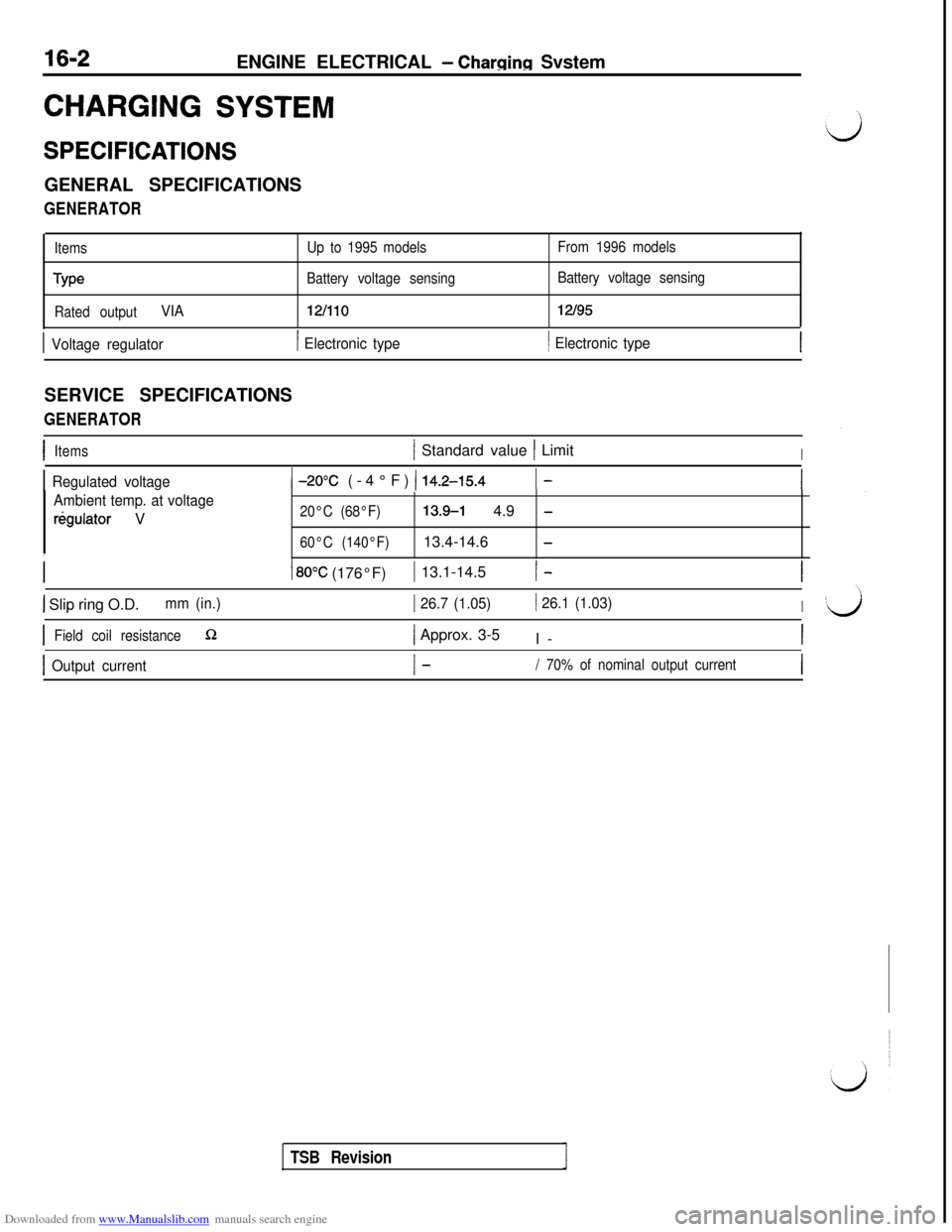
Downloaded from www.Manualslib.com manuals search engine ENGINE ELECTRICAL - Charging Svstem
CHARGING SYSTEM
SPECIFICATIONSGENERAL SPECIFICATIONS
GENERATOR
ItemsUp to 1995 modelsFrom 1996 models
TypeBattery voltage sensingBattery voltage sensing
Rated output
VIA12fllO12l95
1 Voltage regulator1 Electronic type1 Electronic typeSERVICE SPECIFICATIONS
GENERATOR
IItems1 Standard value 1 LimitI
I Regulated voltage
Ambient temp. at voltage
rkgulator V
1 -2O’C (-4°F) ( 14.2-15.41 -I
20°C (68°F)13.9-l 4.9 -
60°C (140°F)13.4-14.6 -IIIII
1 80°C (176°F)1 13.1-14.5I-
1 Slip ring O.D.mm (in.)1 26.7 (1.05)/ 26.1 (1.03)I
IField coil resistanceQ1 Approx. 3-5
I-I
I Output currentI-/ 70% of nominal output currentI
TSB Revision
Page 449 of 738
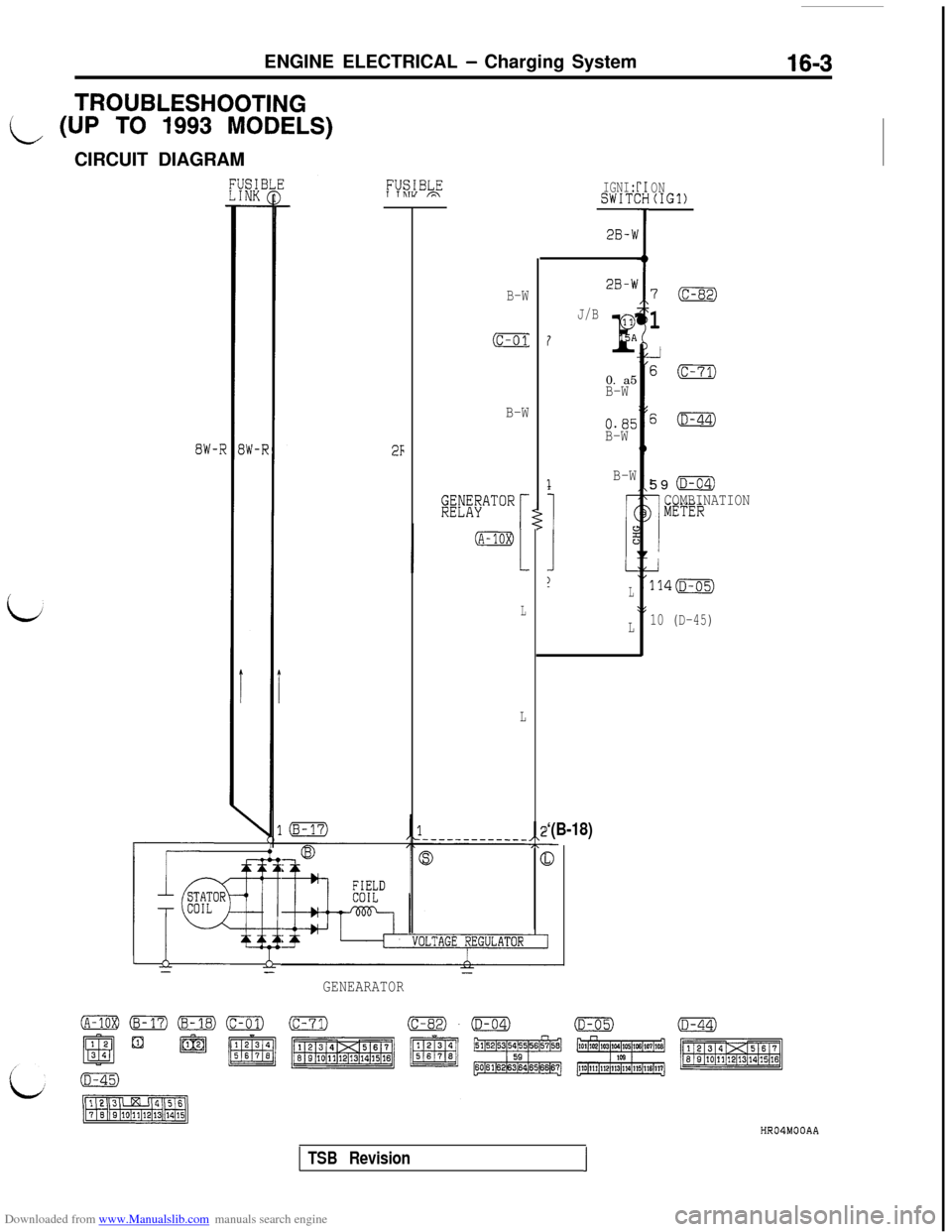
Downloaded from www.Manualslib.com manuals search engine ENGINE ELECTRICAL - Charging System16-3
TROUBLESHOOTING
L (UP TO 1993 MODELS)CIRCUIT DIAGRAM
i
3
i
i!-
IGNI:SWIT(
B-W
(c-01:
B-W
2F
)XF&ATOR
r
L
L
L2
2B-'MI
J/Br015A0. a5
B-W
0.85B-W
B-W
L
L
‘(B-18)
i-d
GENEARATOR
ON(IGl)
7a
159
(D-04)COMBINATION
i
1140
10 (D-45)
TSB RevisionI
Page 450 of 738
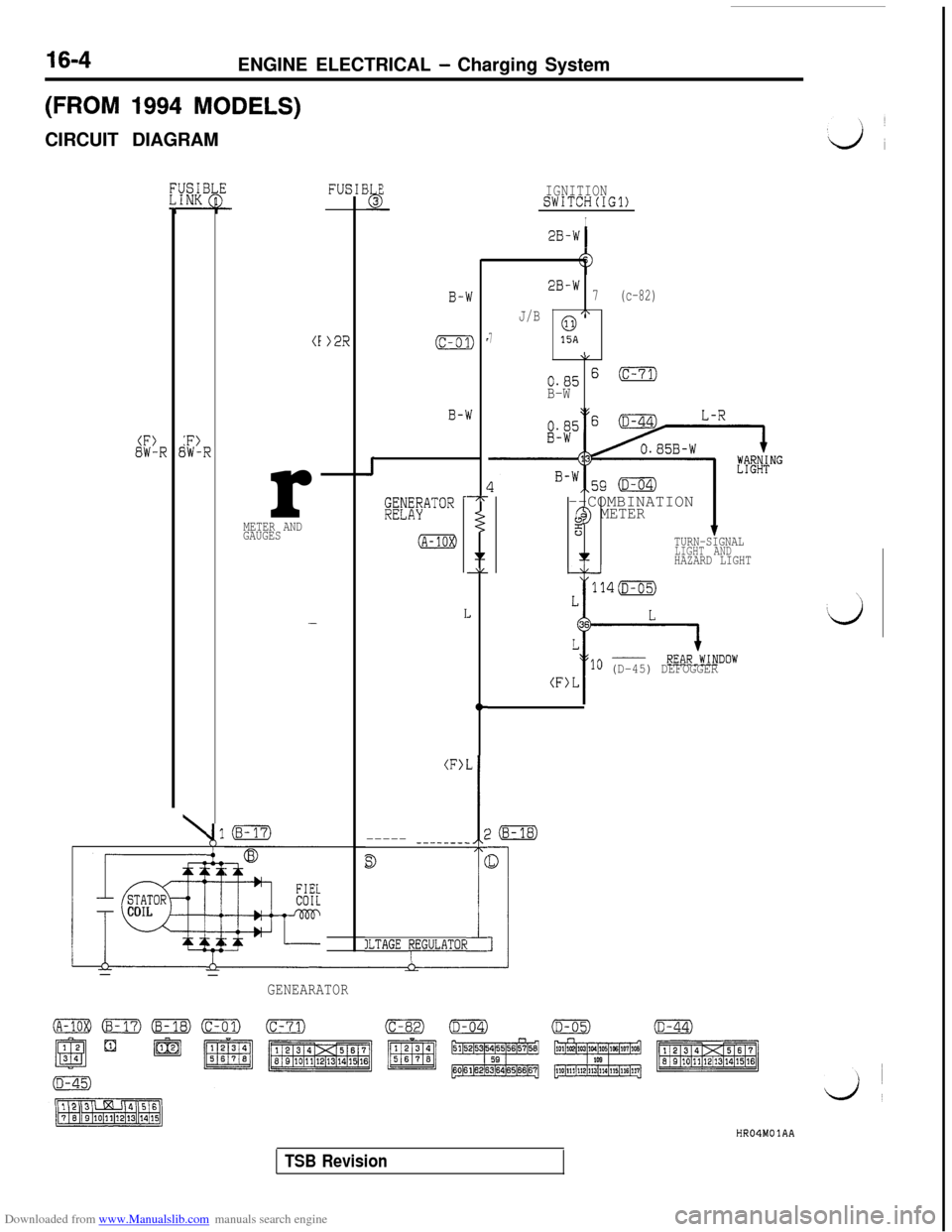
Downloaded from www.Manualslib.com manuals search engine 16-4ENGINE ELECTRICAL - Charging System
(FROM 1994 MODELS)CIRCUIT DIAGRAM
(F)8W-:F>IW-F
\
1
1-8
COIL
-
i
~
i
-
(Ir
METER AND
GAUGES
-
3 Eb3-
B-\
(c-01
B-\
J
gfF;E$ATOR r
(A-1OX)
I
nr
D r
hJ
s-77
3
ILJL
_)
tc
(F>
----- -------.
3
ILTAGE YEGULATOS
L
;
:
(
L
2B-W7(c-82)
J/B,\
0715A
\,0.85
6(c-71)
B-W
--COMBINATION@ METER
z7TURN-SIGNAL
?LIGHT ANDHAZARD LIGHT
GENEARATOR
IGNITIONSWITCH(IG1)
I2B-WI
(Flo (D-45) DEFOGGER
HR04MOlAA
TSB Revision
Page 451 of 738
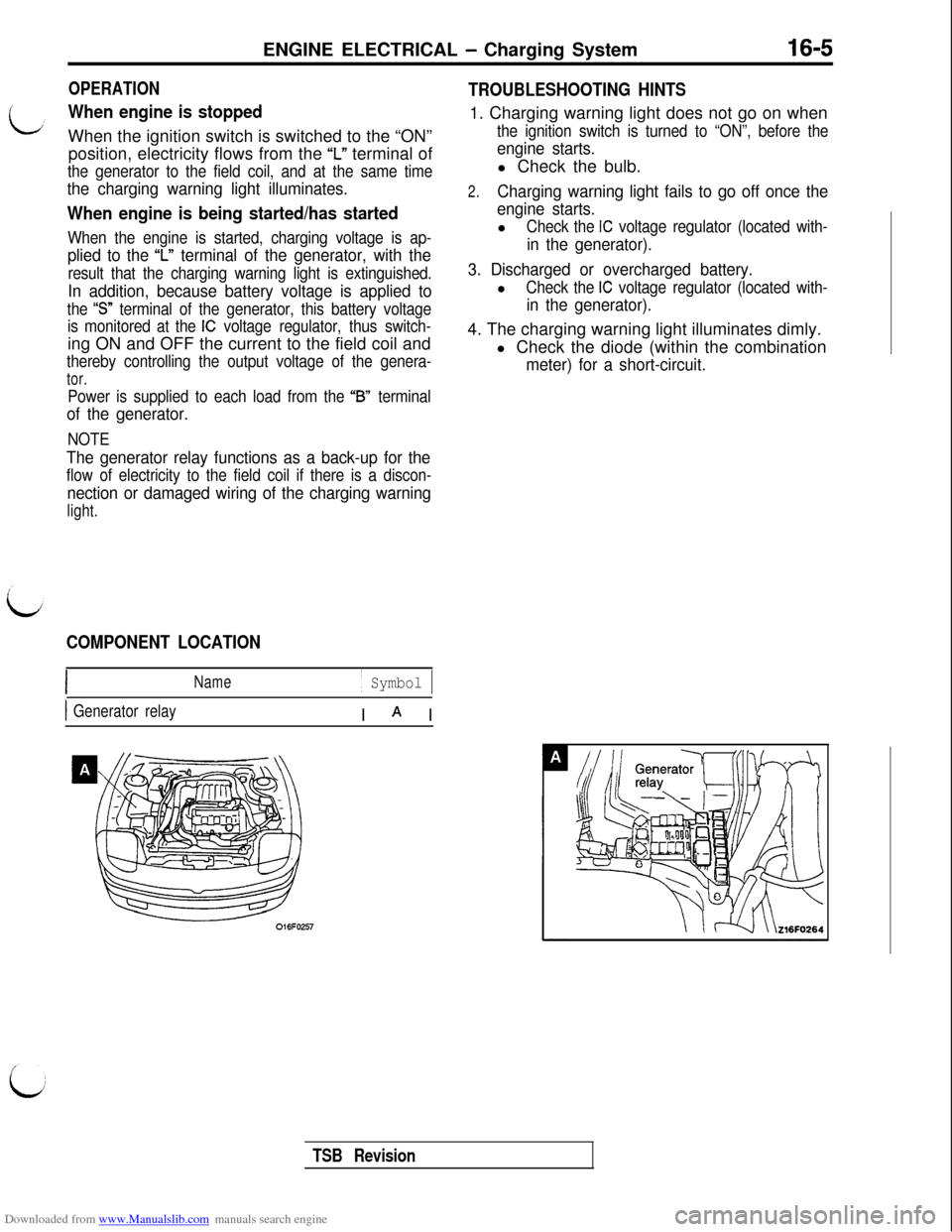
Downloaded from www.Manualslib.com manuals search engine ENGINE ELECTRICAL - Charging System16-5
OPERATION
When engine is stoppedWhen the ignition switch is switched to the “ON”
position, electricity flows from the
‘I” terminal of
the generator to the field coil, and at the same time
the charging warning light illuminates.
When engine is being started/has started
When the engine is started, charging voltage is ap-
plied to the ‘I” terminal of the generator, with the
result that the charging warning light is extinguished.
In addition, because battery voltage is applied to
the “S” terminal of the generator, this battery voltage
is monitored at the
IC voltage regulator, thus switch-ing ON and OFF the current to the field coil and
thereby controlling the output voltage of the genera-
tor.
Power is supplied to each load from the “B” terminal
of the generator.
NOTE
The generator relay functions as a back-up for the
flow of electricity to the field coil if there is a discon-
nection or damaged wiring of the charging warning
light.
COMPONENT LOCATION
Name/ Symbol 1
1 Generator relayI A I
TROUBLESHOOTING HINTS1. Charging warning light does not go on when
the ignition switch is turned to “ON”, before the
engine starts.l Check the bulb.
2.Charging warning light fails to go off once the
engine starts.l
Check the IC voltage regulator (located with-
in the generator).
3. Discharged or overcharged battery.l
Check the IC voltage regulator (located with-
in the generator).4. The charging warning light illuminates dimly.
l Check the diode (within the combination
meter) for a short-circuit.
TSB Revision
Page 452 of 738
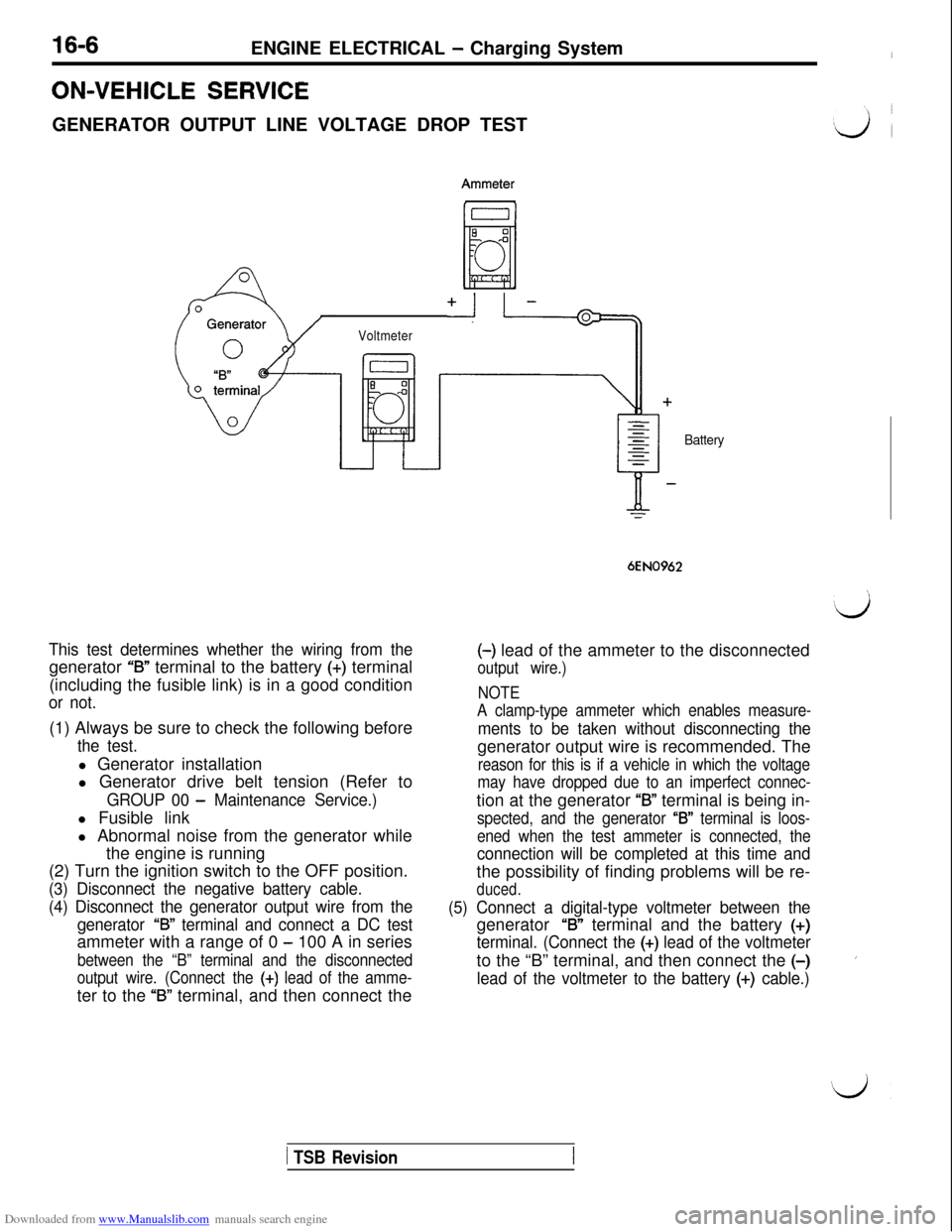
Downloaded from www.Manualslib.com manuals search engine 16-6ENGINE ELECTRICAL - Charging System
ON-VEHICLE SERVICEGENERATOR OUTPUT LINE VOLTAGE DROP TEST
+I I.=-@=
Voltmeter
This test determines whether the wiring from thegenerator
“B” terminal to the battery (+) terminal
(including the fusible link) is in a good condition
or not.(1) Always be sure to check the following before
the test.l Generator installation
l Generator drive belt tension (Refer to
GROUP 00 - Maintenance Service.)l Fusible link
l Abnormal noise from the generator while
the engine is running
(2) Turn the ignition switch to the OFF position.
(3) Disconnect the negative battery cable.
(4) Disconnect the generator output wire from the
generator
‘73” terminal and connect a DC testammeter with a range of 0
- 100 A in series
between the “B” terminal and the disconnected
output wire. (Connect the
(+) lead of the amme-ter to the
‘73” terminal, and then connect the
Battery
6EN0962(-) lead of the ammeter to the disconnected
output wire.)
NOTE
A clamp-type ammeter which enables measure-
ments to be taken without disconnecting thegenerator output wire is recommended. The
reason for this is if a vehicle in which the voltage
may have dropped due to an imperfect connec-tion at the generator
“B” terminal is being in-
spected, and the generator “B” terminal is loos-
ened when the test ammeter is connected, the
connection will be completed at this time andthe possibility of finding problems will be re-
duced.
(5) Connect a digital-type voltmeter between thegenerator
“B” terminal and the battery (+)
terminal. (Connect the (+) lead of the voltmeterto the “B” terminal, and then connect the
(-)
lead of the voltmeter to the battery (+) cable.)
’
1 TSB Revision
Page 453 of 738
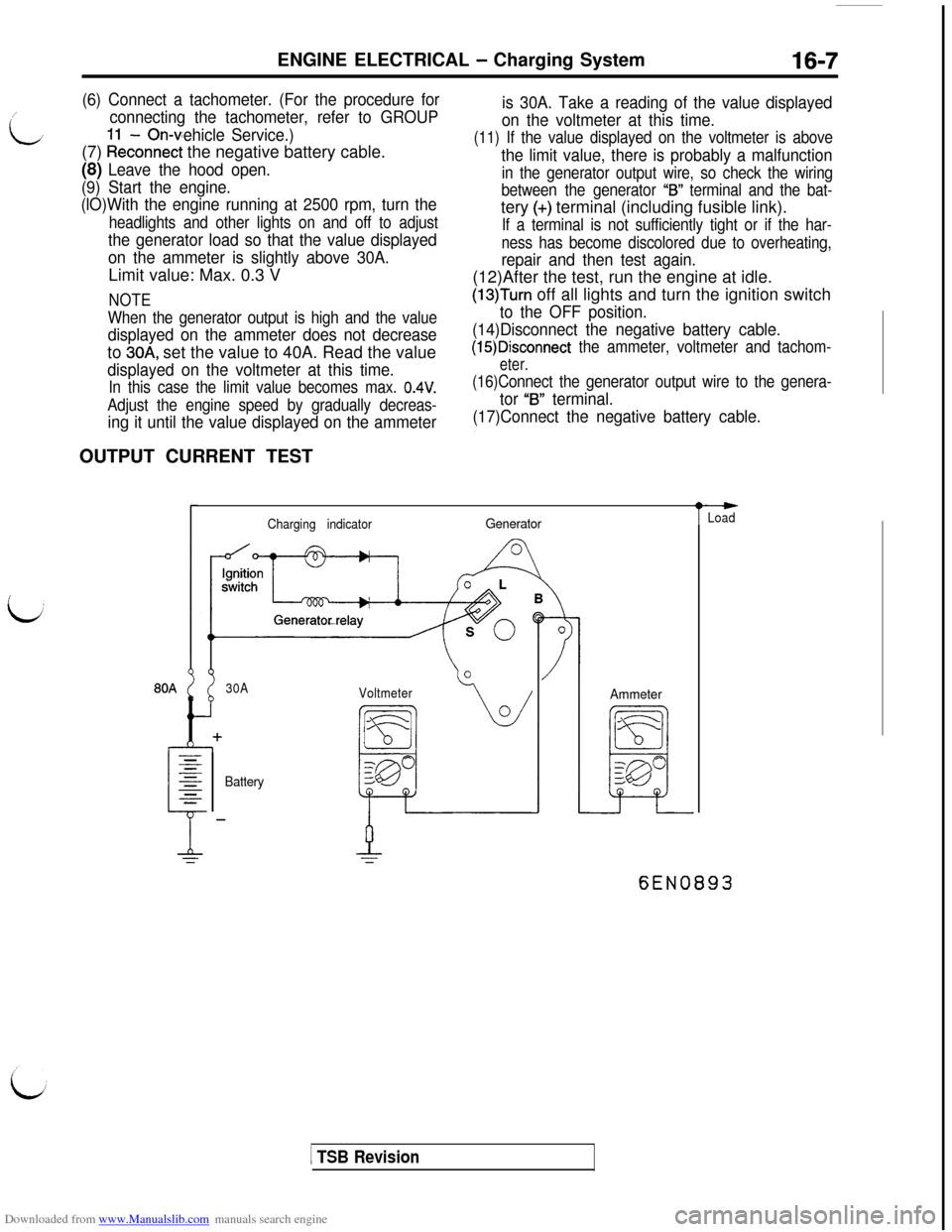
Downloaded from www.Manualslib.com manuals search engine ENGINE ELECTRICAL - Charging System16-7/
L
(6) Connect a tachometer. (For the procedure for
connecting the tachometer, refer to GROUP
- On-vehicle Service.)(7)
kkconnect the negative battery cable.
(8) Leave the hood open.
(9) Start the engine.
(lO)With the engine running at 2500 rpm, turn the
headlights and other lights on and off to adjust
the generator load so that the value displayed
on the ammeter is slightly above 30A.Limit value: Max. 0.3 V
NOTE
When the generator output is high and the value
displayed on the ammeter does not decreaseto
30A, set the value to 40A. Read the value
displayed on the voltmeter at this time.
In this case the limit value becomes max. 0.4V.
Adjust the engine speed by gradually decreas-
ing it until the value displayed on the ammeterOUTPUT CURRENT TEST
is 30A. Take a reading of the value displayed
on the voltmeter at this time.
(11) If the value displayed on the voltmeter is above
the limit value, there is probably a malfunction
in the generator output wire, so check the wiring
between the generator
“IS” terminal and the bat-tery
(+) terminal (including fusible link).
If a terminal is not sufficiently tight or if the har-
ness has become discolored due to overheating,
repair and then test again.(12)After the test, run the engine at idle.
(13)Turn off all lights and turn the ignition switch
to the OFF position.
(14)Disconnect the negative battery cable.
(15)Disconnect the ammeter, voltmeter and tachom-
eter.
(16)Connect the generator output wire to the genera-
tor “B” terminal.
(17)Connect the negative battery cable.
Charging indicatorGenerator
30A
Voltmeter
BatteryAmmeter
t
-Load
6EN0893
1 TSB Revision
Page 454 of 738
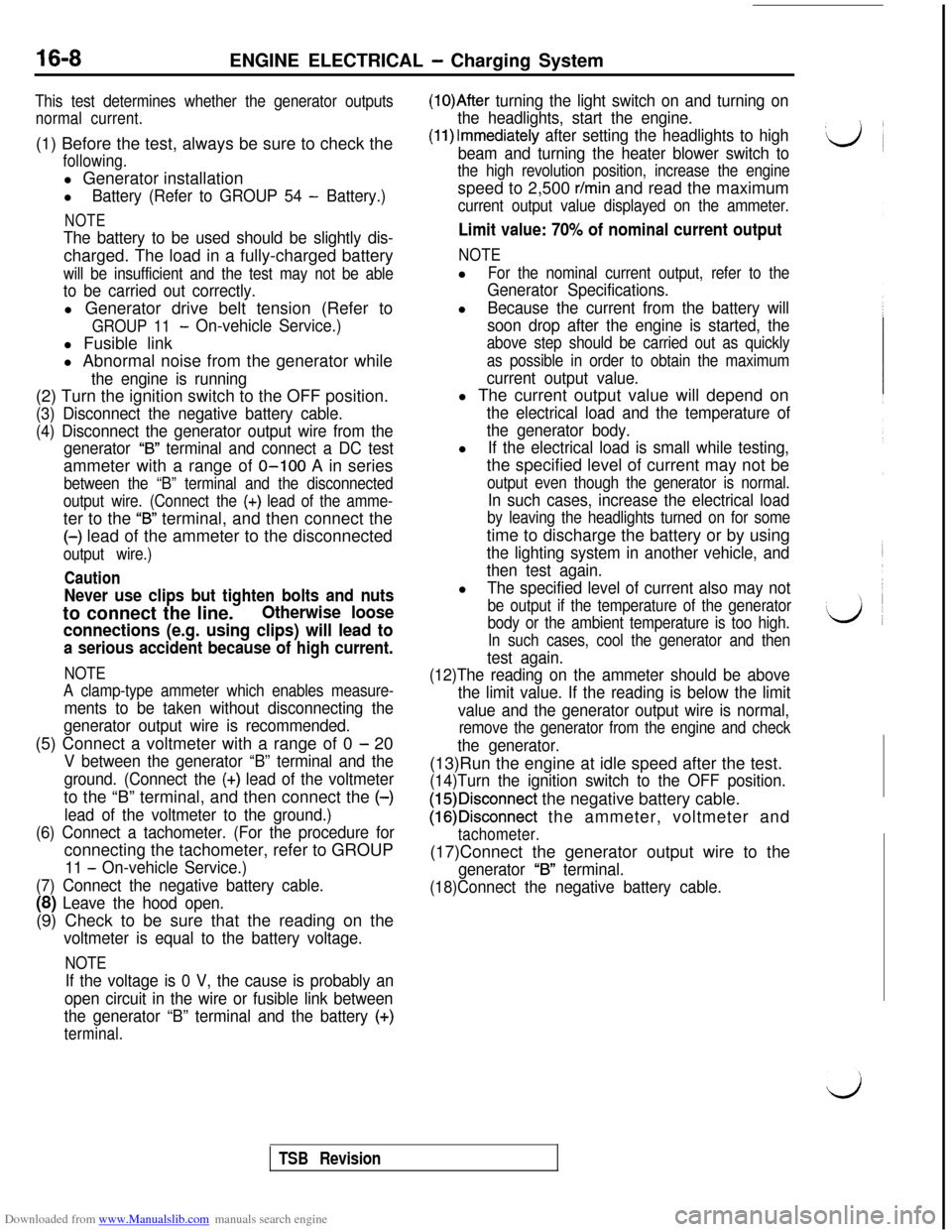
Downloaded from www.Manualslib.com manuals search engine 16-8ENGINE ELECTRICAL - Charging System
This test determines whether the generator outputs
normal current.(1) Before the test, always be sure to check the
following.l Generator installation
l
Battery (Refer to GROUP 54 - Battery.)
NOTE
The battery to be used should be slightly dis-charged. The load in a fully-charged battery
will be insufficient and the test may not be able
to be carried out correctly.l Generator drive belt tension (Refer to
GROUP 11- On-vehicle Service.)l Fusible link
l Abnormal noise from the generator while
the engine is running(2) Turn the ignition switch to the OFF position.
(3) Disconnect the negative battery cable.
(4) Disconnect the generator output wire from the
generator
“B” terminal and connect a DC testammeter with a range of O-100 A in series
between the “B” terminal and the disconnected
output wire. (Connect the
(+) lead of the amme-ter to the
“B” terminal, and then connect the(-) lead of the ammeter to the disconnected
output wire.)
Caution
Never use clips but tighten bolts and nutsto connect the line.
Otherwise loose
connections (e.g. using clips) will lead to
a serious accident because of high current.
NOTE
A clamp-type ammeter which enables measure-
ments to be taken without disconnecting the
generator output wire is recommended.(5) Connect a voltmeter with a range of 0
- 20
V between the generator “B” terminal and the
ground. (Connect the
(+) lead of the voltmeterto the “B” terminal, and then connect the (-)
lead of the voltmeter to the ground.)
(6) Connect a tachometer. (For the procedure forconnecting the tachometer, refer to GROUP
11 - On-vehicle Service.)
(7) Connect the negative battery cable.
(8) Leave the hood open.(9) Check to be sure that the reading on the
voltmeter is equal to the battery voltage.
NOTE
If the voltage is 0 V, the cause is probably an
open circuit in the wire or fusible link between
the generator “B” terminal and the battery
(+)
terminal.
(1O)After turning the light switch on and turning on
the headlights, start the engine.
(1l)lmmediately after setting the headlights to high
beam and turning the heater blower switch to
the high revolution position, increase the enginespeed to 2,500
r/min and read the maximum
current output value displayed on the ammeter.
Limit value: 70% of nominal current output
NOTEl
For the nominal current output, refer to the
Generator Specifications.l
Because the current from the battery will
soon drop after the engine is started, the
above step should be carried out as quickly
as possible in order to obtain the maximum
current output value.l The current output value will depend on
the electrical load and the temperature of
the generator body.l
If the electrical load is small while testing,the specified level of current may not be
output even though the generator is normal.
In such cases, increase the electrical load
by leaving the headlights turned on for sometime to discharge the battery or by using
the lighting system in another vehicle, and
then test again.l
The specified level of current also may not
be output if the temperature of the generator
body or the ambient temperature is too high.
In such cases, cool the generator and then
test again.
(12)The reading on the ammeter should be above
the limit value. If the reading is below the limit
value and the generator output wire is normal,
remove the generator from the engine and check
the generator.(13)Run the engine at idle speed after the test.
(14)Turn the ignition switch to the OFF position.
(15)Disconnect the negative battery cable.
(16)Disconnect the ammeter, voltmeter and
tachometer.(17)Connect the generator output wire to the
generator “B” terminal.
(18)Connect the negative battery cable.
TSB Revision
Page 455 of 738
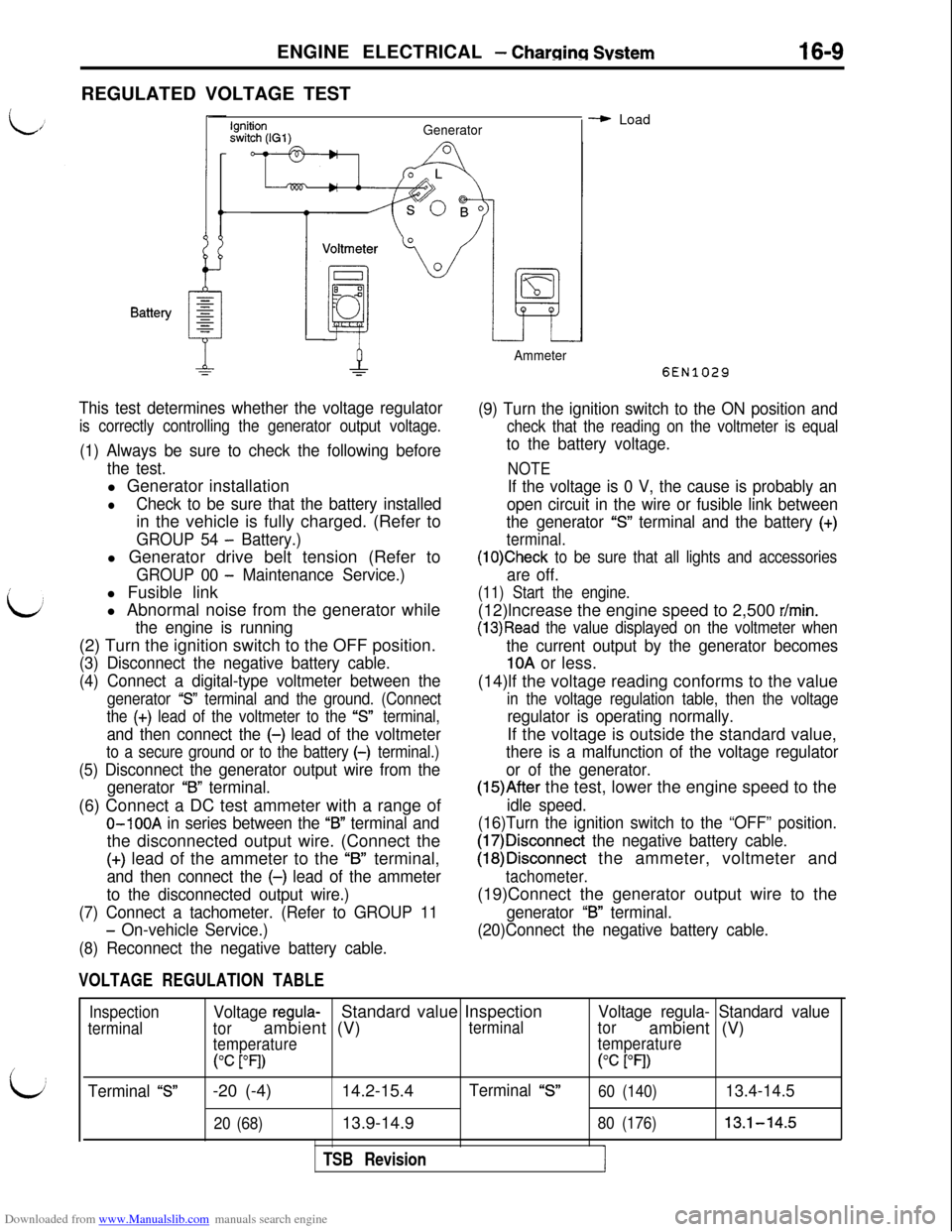
Downloaded from www.Manualslib.com manuals search engine ENGINE ELECTRICAL - Charging Svstem16-9REGULATED VOLTAGE TEST
\:
b
Ignitionswitch (IGl)Generator
This test determines whether the voltage regulator
is correctly controlling the generator output voltage.
(1) Always be sure to check the following before
the test.l Generator installation
lCheck to be sure that the battery installedin the vehicle is fully charged. (Refer to
GROUP 54 - Battery.)l Generator drive belt tension (Refer to
GROUP 00 - Maintenance Service.)l Fusible link
l Abnormal noise from the generator while
the engine is running(2) Turn the ignition switch to the OFF position.
(3) Disconnect the negative battery cable.
(4) Connect a digital-type voltmeter between the
generator “S” terminal and the ground. (Connect
the
(+) lead of the voltmeter to the “s” terminal,
and then connect the (-) lead of the voltmeter
to a secure ground or to the battery (-) terminal.)
(5) Disconnect the generator output wire from the
generator
“B” terminal.(6) Connect a DC test ammeter with a range of
O-100A in series between the “B” terminal andthe disconnected output wire. (Connect the
(+) lead of the ammeter to the “B” terminal,
and then connect the (-) lead of the ammeter
to the disconnected output wire.)
(7) Connect a tachometer. (Refer to GROUP 11
- On-vehicle Service.)
(8) Reconnect the negative battery cable.
VOLTAGE REGULATION TABLE
Ammeter
- Load
6EN1029
(9) Turn the ignition switch to the ON position and
check that the reading on the voltmeter is equal
to the battery voltage.
NOTE
If the voltage is 0 V, the cause is probably an
open circuit in the wire or fusible link between
the generator
“S” terminal and the battery (+)
terminal.
(1O)Check to be sure that all lights and accessories
are off.
(11) Start the engine.(12)lncrease the engine speed to 2,500
r/min.
(13)Read the value displayed on the voltmeter when
the current output by the generator becomes
10A or less.
(14)lf the voltage reading conforms to the value
in the voltage regulation table, then the voltage
regulator is operating normally.If the voltage is outside the standard value,
there is a malfunction of the voltage regulator
or of the generator.
(15)After the test, lower the engine speed to the
idle speed.
(16)Turn the ignition switch to the “OFF” position.
(17)Disconnect the negative battery cable.
(18)Disconnect the ammeter, voltmeter and
tachometer.(19)Connect the generator output wire to the
generator “B” terminal.
(20)Connect the negative battery cable.
Inspection
terminal
Terminal “S”
Voltage regula-Standard value Inspection
torambient (V)terminal
temperature
(“C PI)-20 (-4)14.2-15.4
Terminal “S”
20 (68)13.9-14.9
TSB Revision
Voltage regula- Standard value
torambient (V)
temperature(“c
PI)
60 (140)13.4-14.5
80 (176)13.1-14.5
I
Page 457 of 738
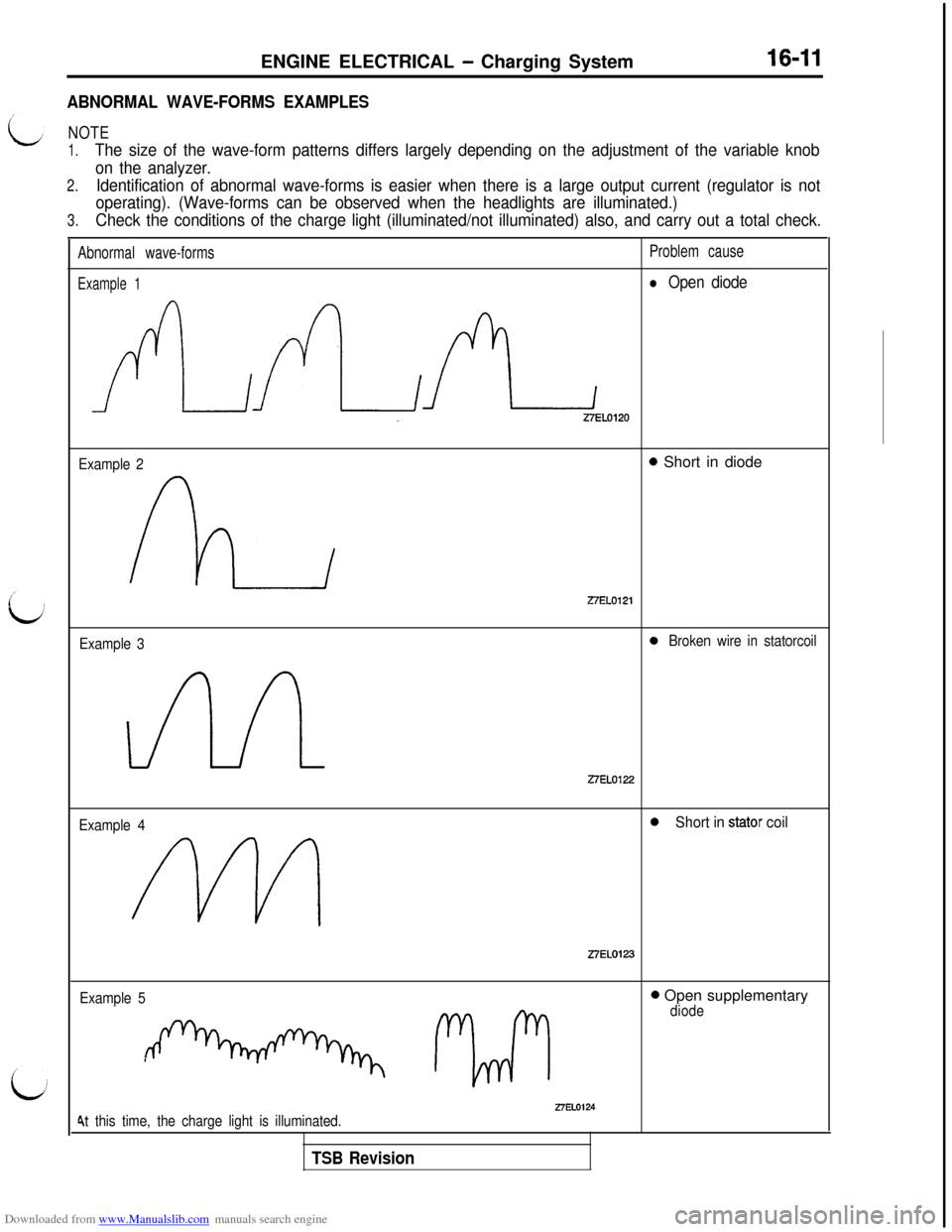
Downloaded from www.Manualslib.com manuals search engine ENGINE ELECTRICAL - Charging System16-11
ABNORMAL WAVE-FORMS EXAMPLES
NOTE
1.The size of the wave-form patterns differs largely depending on the adjustment of the variable knob
on the analyzer.
2.Identification of abnormal wave-forms is easier when there is a large output current (regulator is not
operating). (Wave-forms can be observed when the headlights are illuminated.)
3.Check the conditions of the charge light (illuminated/not illuminated) also, and carry out a total check.
Abnormal wave-formsProblem cause
Example 1l Open diode
AALZELOlZO
Example 20 Short in diodeZ7EL0121
Example 30Broken wire in statorcoil
27EL0122
Example 40Short in stator coil
Z7EL0123
Example 5
1 r2rrirl
0 Open supplementarydiode
27EL01244t this time, the charge light is illuminated.
TSB Revision
Page 458 of 738
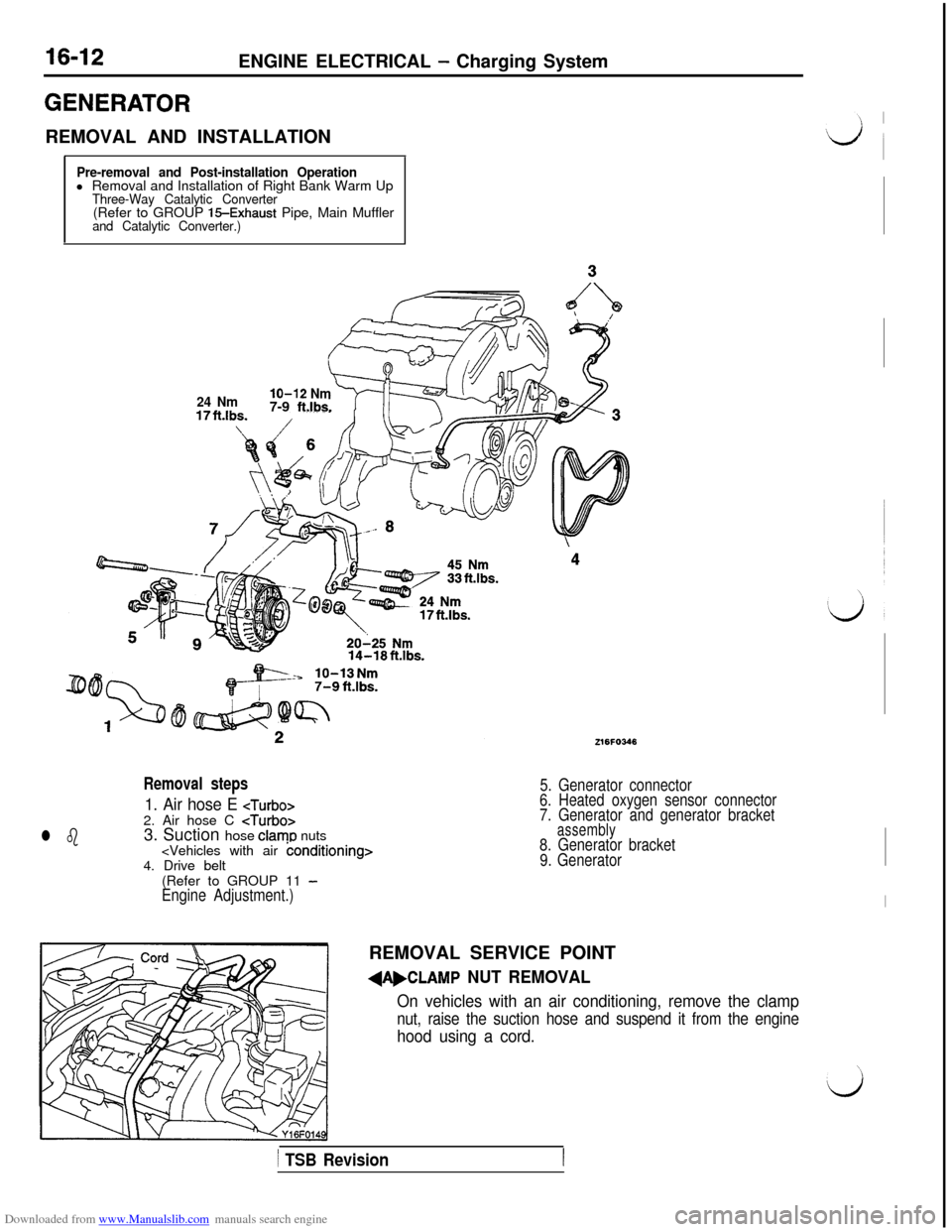
Downloaded from www.Manualslib.com manuals search engine 16-12ENGINE ELECTRICAL - Charging System
GENERATORREMOVAL AND INSTALLATION
Pre-removal and Post-installation Operationl Removal and Installation of Right Bank Warm Up
Three-Way Catalytic Converter(Refer to GROUP 15-Exhaust Pipe, Main Mufflerand Catalytic Converter.)14-18ft.lbs.
l b
Removal steps
1. Air hose E
3. Suction hose clamo nuts
(Refer to GROUP 11
-Engine Adjustment.)
216FO346
5. Generator connector
6. Heated oxygen sensor connector
7. Generator and generator bracket
assembly8. Generator bracket
9. Generator
lo-12 Nm7-9 ft.lbs.24 NmREMOVAL SERVICE POINT
dAbCLAMP NUT REMOVAL
On vehicles with an air conditioning, remove the clamp
nut, raise the suction hose and suspend it from the engine
hood using a cord.
1 TSB Revision